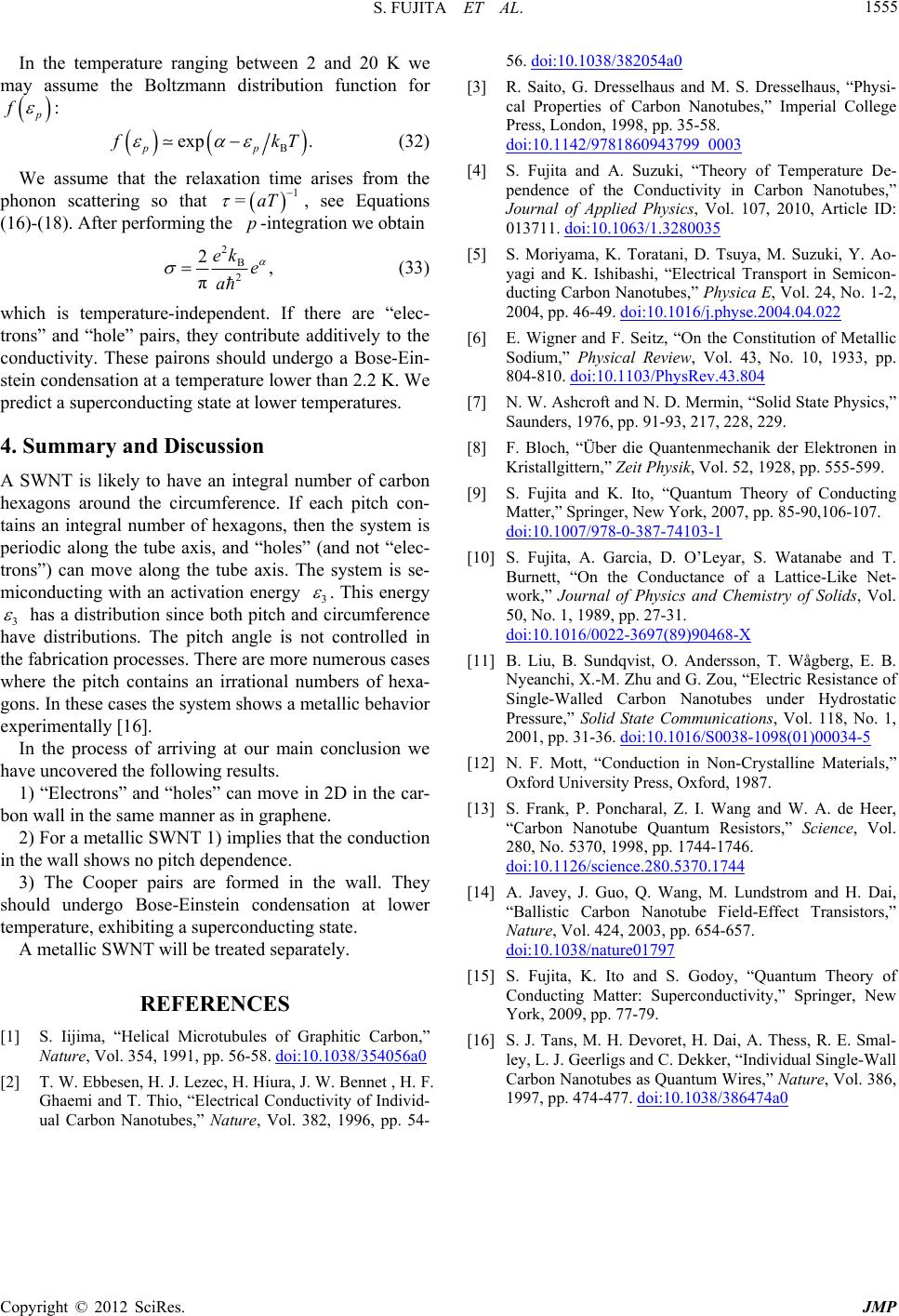
S. FUJITA ET AL.
Copyright © 2012 SciRes. JMP
1555
In the temperature ranging between 2 and 20 K we
may assume the Boltzmann distribution function for
f
:
Bp
exp
p.
kT
1
=aT
p
(32)
We assume that the relaxation time arises from the
phonon scattering so that , see Equations
(16)-(18). After performing the -integration we obtain
2
B
2
2,
π
ek e
a
(33)
which is temperature-independent. If there are “elec-
trons” and “hole” pairs, they contribute additively to the
conductivity. These pairons should undergo a Bose-Ein-
stein condensation at a temperature lower than 2.2 K. We
predict a superconducting state at lower temperatures.
4. Summary and Discussion
A SWNT is likely to have an integral number of carbon
hexagons around the circumference. If each pitch con-
tains an integral number of hexagons, then the system is
periodic along the tube axis, and “holes” (and not “elec-
trons”) can move along the tube axis. The system is se-
miconducting with an activation energy 3
. This energy
3
has a distribution since both pitch and circumference
have distributions. The pitch angle is not controlled in
the fabrication processes. There are more numerous cases
where the pitch contains an irrational numbers of hexa-
gons. In these cases the system shows a metallic behavior
experimentally [16].
In the process of arriving at our main conclusion we
have uncovered the following results.
1) “Electrons” and “holes” can move in 2D in the car-
bon wall in the same manner as in graphene.
2) For a metallic SWNT 1) implies that the conduction
in the wall shows no pitch dependence.
3) The Cooper pairs are formed in the wall. They
should undergo Bose-Einstein condensation at lower
temperature, exhibiting a superconducting state.
A metallic SWNT will be treated separately.
REFERENCES
[1] S. Iijima, “Helical Microtubules of Graphitic Carbon,”
Nature, Vol. 354, 1991, pp. 56-58. doi:10.1038/354056a0
[2] T. W. Ebbesen, H. J. Lezec, H. Hiura, J. W. Bennet , H. F.
Ghaemi and T. Thio, “Electrical Conductivity of Individ-
ual Carbon Nanotubes,” Nature, Vol. 382, 1996, pp. 54-
56. doi:10.1038/382054a0
[3] R. Saito, G. Dresselhaus and M. S. Dresselhaus, “Physi-
cal Properties of Carbon Nanotubes,” Imperial College
Press, London, 1998, pp. 35-58.
doi:10.1142/9781860943799_0003
[4] S. Fujita and A. Suzuki, “Theory of Temperature De-
pendence of the Conductivity in Carbon Nanotubes,”
Journal of Applied Physics, Vol. 107, 2010, Article ID:
013711. doi:10.1063/1.3280035
[5] S. Moriyama, K. Toratani, D. Tsuya, M. Suzuki, Y. Ao-
yagi and K. Ishibashi, “Electrical Transport in Semicon-
ducting Carbon Nanotubes,” Physica E, Vol. 24, No. 1-2,
2004, pp. 46-49. doi:10.1016/j.physe.2004.04.022
[6] E. Wigner and F. Seitz, “On the Constitution of Metallic
Sodium,” Physical Review, Vol. 43, No. 10, 1933, pp.
804-810. doi:10.1103/PhysRev.43.804
[7] N. W. Ashcroft and N. D. Mermin, “Solid State Physics,”
Saunders, 1976, pp. 91-93, 217, 228, 229.
[8] F. Bloch, “Über die Quantenmechanik der Elektronen in
Kristallgittern,” Z eit Physik, Vol. 52, 1928, pp. 555-599.
[9] S. Fujita and K. Ito, “Quantum Theory of Conducting
Matter,” Springer, New York, 2007, pp. 85-90,106-107.
doi:10.1007/978-0-387-74103-1
[10] S. Fujita, A. Garcia, D. O’Leyar, S. Watanabe and T.
Burnett, “On the Conductance of a Lattice-Like Net-
work,” Journal of Physics and Chemistry of Solids, Vol.
50, No. 1, 1989, pp. 27-31.
doi:10.1016/0022-3697(89)90468-X
[11] B. Liu, B. Sundqvist, O. Andersson, T. Wågberg, E. B.
Nyeanchi, X.-M. Zhu and G. Zou, “Electric Resistance of
Single-Walled Carbon Nanotubes under Hydrostatic
Pressure,” Solid State Communications, Vol. 118, No. 1,
2001, pp. 31-36. doi:10.1016/S0038-1098(01)00034-5
[12] N. F. Mott, “Conduction in Non-Crystalline Materials,”
Oxford University Press, Oxford, 1987.
[13] S. Frank, P. Poncharal, Z. I. Wang and W. A. de Heer,
“Carbon Nanotube Quantum Resistors,” Science, Vol.
280, No. 5370, 1998, pp. 1744-1746.
doi:10.1126/science.280.5370.1744
[14] A. Javey, J. Guo, Q. Wang, M. Lundstrom and H. Dai,
“Ballistic Carbon Nanotube Field-Effect Transistors,”
Nature, Vol. 424, 2003, pp. 654-657.
doi:10.1038/nature01797
[15] S. Fujita, K. Ito and S. Godoy, “Quantum Theory of
Conducting Matter: Superconductivity,” Springer, New
York, 2009, pp. 77-79.
[16] S. J. Tans, M. H. Devoret, H. Dai, A. Thess, R. E. Smal-
ley, L. J. Geerligs and C. Dekker, “Individual Single-Wall
Carbon Nanotubes as Quantum Wires,” Nature, Vol. 386,
1997, pp. 474-477. doi:10.1038/386474a0